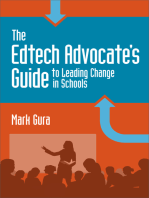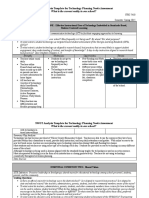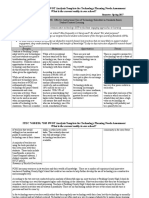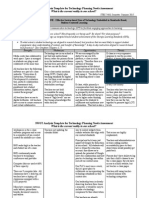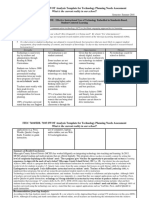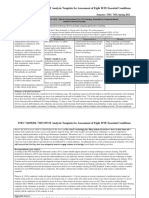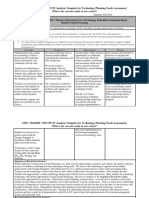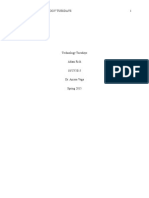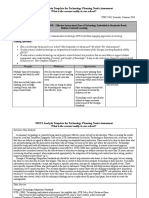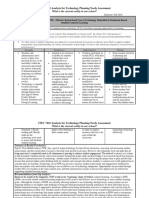SWOT Analysis Template For Technology Planning Needs Assessment
SWOT Analysis Template For Technology Planning Needs Assessment
Uploaded by
api-284877281Copyright:
Available Formats
SWOT Analysis Template For Technology Planning Needs Assessment
SWOT Analysis Template For Technology Planning Needs Assessment
Uploaded by
api-284877281Original Title
Copyright
Available Formats
Share this document
Did you find this document useful?
Is this content inappropriate?
Copyright:
Available Formats
SWOT Analysis Template For Technology Planning Needs Assessment
SWOT Analysis Template For Technology Planning Needs Assessment
Uploaded by
api-284877281Copyright:
Available Formats
SWOT Analysis Template for Technology Planning Needs Assessment
What is the current reality in our school?
Name:
Tracy Castleberry
ITEC 7410, Semester: Spring 2015
ESSENTIAL CONDITION ONE: Effective Instructional Uses of Technology Embedded in Standards-Based,
Student-Centered Learning
ISTE Definition: Use of information and communication technology (ICT) to facilitate engaging approaches to learning.
Guiding Questions:
How is technology being used in our school? How frequently is it being used? By whom? For what purposes?
To what extent is student technology use targeted toward student achievement of the Georgia Learning Standards (GPSs,
QCCs)?
To what extent is student technology use aligned to research-based, best practices that are most likely to support student
engagement, deep understanding of content, and transfer of knowledge? Is day-to-day instruction aligned to research-based
best practices? (See Creighton Chapters 5, 7)
Strengths
Weaknesses
Opportunities
Threats
Teachers use
Technology is often
Development (maybe as
Some teachers do not
technology in the
used for drill and
an incentive program
feel comfortable
classroom frequently
practice and review,
for teachers) of
integrating technology
rather than developing
technology-based
in their classrooms
Technology is
and
using
higher
order
lessons
that
support
With increased teacher
integrated in class
thinking skills
authentic learning,
curriculum
responsibilities,
higher
order
thinking
Opportunities
for
using
teachers struggle to find
Technology is used to
skills and project based
technology in project
time to develop
support best-practice by
learning
based
learning
are
technology lessons to
teaching new content,
Create a data-base of
limited
foster authentic and
summarizing and
more
interactive
higher level thinking
In some classes,
review previous content
SMART board lessons
skills.
SMART boards and
All classrooms are
divided
by
subject
area
Because technology
under-utilized as a
equipped with SMART
that all teachers can
student tool and overcoaches are stretched so
board and projectors
access
and
use
utilized as a teacher
thin, teachers lack
Teacher laptops are
Administrators
and
tool.
opportunities for
used for productivity,
department
chairs
could
ongoing support after
There are no specific
communication and
come up with minimal
professional
guidelines regarding
instruction
requirements
for
teacher
development
information that should
School is working
websites and
Because of pressure of
be on teacher websites
towards becoming a
communicate those to
End of Course Ga
SWOT Analysis Template for Technology Planning Needs Assessment
What is the current reality in our school?
STEM academy
Teachers have a county
email address to
communicate with
teachers, parents and
students
All teachers have a
website for
communication
ASPEN (family portal)
is used for students and
parents to keep up with
their grades
Administration is
supportive of
technology integration
and innovative
educational strategies
Cherokee County uses
the BYLD (bring you
learning device) for
immediate access to
technology for students
in the classroom
Many teacher websites
have outdated or
missing information
Technology use plan is
not directly tied to
STEM objectives
Guiding students
towards appropriate use
of technology regarding
BYLD (bring your
learning device) is a
challenge
teachers
Specific technology
needs assessment and
goals development that
relate specifically to
STEM
A shared drive can be
set up to house BYLD
lessons for all teachers
to see, adapt and use
Milestones and SLOs,
teachers are stressed to
prepare students for the
test and do not have
time to integrate enough
technology in the
classroom.
Not all teachers share
the same viewpoints
regarding the use of
technology in the
classroom
BYLD can bring a new
level of classroom
management issues
regarding the
appropriate use of
technology in the
classroom
Summary/Gap Analysis:
At Woodstock High School, there is a significant amount of technology that is available for use by students and teachers. Websites
and teacher and student emails addresses help to support communication between all stakeholders.
SWOT Analysis Template for Technology Planning Needs Assessment
What is the current reality in our school?
BYLD (bring your learning device) is an excellent way for students to have immediate access to technology in the classroom with
teacher permission. BYLD can be integrated into a variety of lessons, that way; teachers that do not have a mobile lab can still allow
their students to use technology in the classroom. Specific BYLD lesson plans can be shared so that teachers can see what types of
activities others are using in their classrooms.
Technology is used and integrated into classes in many ways, but more emphasis should be put on project based learning, authentic
learning experiences and higher order thinking skills and less on review and drill and practice. Technology should be used more to
help develop collaboration and students discovering knowledge on their own rather than drill and practice and review.
Data Sources:
Woodstock High SchoolSchool Improvement Plan 2013- 2014 (http://portal.cherokee.k12.ga.us/Schools/woodstockhs/school_info/School%20Improvement%20Plan/Woodstock%20HS%202013-14%20School%20Improvement%20Plan.pdf)
Cherokee County Three- Year Technology Plan
(http://www.cherokee.k12.ga.us/departments/technology/Documents/StateTechPlan-2014-2017.pdf)
ISTE Technology Standards for Students (http://www.iste.org/standards/standards-for-students)
Shared Vision for Technology Staff Survey
ISTE Diagnostic Tool
ESSENTIAL CONDITION TWO: Shared Vision
ISTE Definition: Proactive leadership in developing a shared vision for educational technology among school personnel, students,
parents, and the community.
Guiding Questions:
Is there an official vision for technology use in the district/school? Is it aligned to research-best practices? Is it aligned to
state and national visions? Are teachers, administrators, parents, students, and other community members aware of the vision?
To what extent do teachers, administrators, parents, students, and other community members have a vision for how technology
can be used to enhance student learning? What do they believe about technology and what types of technology uses we should
encourage in the future? Are their visions similar or different? To what extent are their beliefs about these ideal, preferred
technology uses in the future aligned to research and best practice?
To what extent do educators view technology as critical for improving student achievement of the GPS/QCCs? To preparing
SWOT Analysis Template for Technology Planning Needs Assessment
What is the current reality in our school?
tomorrows workforce? For motivating digital-age learners?
What strategies have been deployed to date to create a research-based shared vision?
What needs to be done to achieve broad-scale adoption of a research-based vision for technology use that is likely to lead to
improved student achievement?
Strengths
Weaknesses
Opportunities
Threats
Woodstock High School
uses the Cherokee
County Technology
Plan to help guide the
use of technology in the
school
The technology vision
is thorough and
complete and aligned to
best practices regarding
use of technology to
foster higher-order
thinking skills
Teachers and
administrators are
aware of the shared
vision for technology
use (school survey)
Vision for technology
use is aligned with
NETS- National
Technology Standards
Senior project, or
VisionQuest is one way
that students use
technology to
communicate and
collaborate with
community leaders
Alignment with GPS
and Common Core
Standards are not
discussed in technology
vision
Many teachers are
unaware of NETS
standards and therefore
are not always
integrating technology
in the best possible
ways
Teachers are not trained
in integration of
technology standards
Technology leaders in
schools are stretched
thin and teachers often
do not receive the
support needed to
effectively integrate
technology into their
classrooms
Many classroom uses of
technology still center
around drill and practice
rather than higher order
thinking skills (school
survey)
SPLOST funds are
available for purchasing
of technology hardware
for use in the schools
Community
involvement and
partnerships with local
universities would
greatly enhance the
real-world applications
of technology and help
to bring students
learning outside the
classroom walls
Grants can possibly
supplement the
purchase of assistive
technology to help
bridge a gap between
students with
disabilities and the
content
If teachers were
surveyed and their
viewpoints were taken
into consideration when
developing a shared
vision, there might be
more support from
Teacher viewpoints on
how technology should
be implemented vary
greatly (school survey)
Technology changes so
much that its hard to
stay ahead of the
changing trends
County personnel and
administrators often are
the ones approving
technology purchases,
when it is the teachers
that are using the
technology in their
classrooms
SWOT Analysis Template for Technology Planning Needs Assessment
What is the current reality in our school?
teachers
Summary/Gap Analysis:
The shared vision for technology implementation is part of the Cherokee County Three Year Technology Plan. The vision is district
wide, though it is divided into separate sections for elementary, middle and high. According to the shared vision survey administered
at Woodstock High School, the majority of teachers and administrators are aware of the shared vision. I did not survey parents and
students because I was not cleared to do this by my administration. Teachers believe that technology should be used to review
previous material, summarize material and to teach new material. Also, a one teacher commented that technology should not be
integrated at all until the students learn how to think.
Mostly, teachers and administrators have a similar vision for technology integration. Both groups believe that technology should be
used to support authentic learning in the classroom, as well as teach new material, review previous material and summarize.
Technology used to formatively assess students is also useful because it is a tool that teachers can use to help identify weaknesses and
re-teach if needed.
VisionQuest, Cherokee Countys senior project, allows 12th graders to use technology to communicate and collaborate with
community leaders to develop their project. Further collaboration with the community and local colleges and universities would only
supplement and enhance the use of technology to support higher order thinking skills and authentic learning opportunities.
By analyzing available technology, the Cherokee County technology plan uses research to justify the types of hardware and software
to be purchased and integrated by grade levels. Also, the Woodstock High School SIP (school improvement plan) discusses all the
software available and how that software is to be used in different grade/subject levels.
According to the ISTE diagnostic tool, Woodstock High School scored a 63 %, which is at the approaching level.
Data Sources:
Woodstock High SchoolSchool Improvement Plan 2013- 2014 (http://portal.cherokee.k12.ga.us/Schools/woodstockhs/school_info/School%20Improvement%20Plan/Woodstock%20HS%202013-14%20School%20Improvement%20Plan.pdf)
Cherokee County Three- Year Technology Plan
(http://www.cherokee.k12.ga.us/departments/technology/Documents/StateTechPlan-2014-2017.pdf)
ISTE Technology Standards for Students (http://www.iste.org/standards/standards-for-students)
Shared Vision for Technology Staff Survey
ISTE Diagnostic Tool
SWOT Analysis Template for Technology Planning Needs Assessment
What is the current reality in our school?
ESSENTIAL CONDITION THREE: Planning for Technology
ISTE Definition: A systematic plan aligned with a shared vision for school effectiveness and student learning through the infusion of
ICT and digital learning resources.
Guiding Questions:
Is there an adequate plan to guide technology use in your school? (either at the district or school level? Integrated into SIP?)
What should be done to strengthen planning?
Strengths
Weaknesses
Opportunities
Threats
Goals are clearly stated
with data and action
plans
Funding sources and
cost analysis provided
for each goal
Data sources are listed
and explained
Data analysis is present
Woodstock Highs
School improvement
plan specifically targets
technology, complete
with goals
Software available to all
content areas and to
Special Education is
listed and described in
school SIP
The SIP does not
provide information on
how the NETS
standards and
technology are
integrated in GPS and
Common Core
standards
Some time-lines listed
in the SIP are ASAP
but the issues are not
addressed in a timely
manner
BYLD is a great idea,
but it has issues in
implementation that
make it hard to use in
the classroom
If teachers were more
involved in the
technology plan, then
there would be more
buy-in from
classroom teachers
Subject area leads at the
high school level could
also be technology
leaders and offer input
to the technology
planning process (or at
least one per
department)
Teachers could appoint
a tech-savvy student in
each class to be a
technology leader and
provide feedback that
the teacher could take
back to their department
regarding effective
technology use in the
Not using available
budget to choose the
most effective tools for
technology in the
classroom
Not using research to
help choose the tools
mentioned above
SWOT Analysis Template for Technology Planning Needs Assessment
What is the current reality in our school?
classroom
Summary/Gap Analysis:
Cherokee Countys Three Year Technology plan has a clear vision for technology use in the district and uses research to back up the
plan. The plan is clearly stated and has goals and strategies listed to help meet those goals. Woodstock High School SIP also has a
technology plan, and it discusses specific issues that pertain to the school specifically and this is important because sometimes the
district plan is too broad. However, even with the best intentions, there are still gaps. Two of the goals on the SIP regarding
technology are specific to science, and neither of those issues have been addressed. There is still one room on the science hall that has
no wireless access.
Using teachers in the technology planning process could strengthen planning. Teachers are the ones that are directly responsible for
the technology that is implemented in their classrooms, and they have very little input in planning. If teachers had more to do with the
planning process, the buy in from teachers would no doubt be higher, which would be the most beneficial for the students.
Teachers, according to the school survey, are aware of the technology plan, but they have little to no input in the development of the
plan. If a select group of teachers were chosen to be on the county technology committee, these teachers could take input from their
schools to the county level and help technology planning be more effective.
According to the ISTE diagnostic tool, Woodstock High School scored 82 % on implementation planning, which is at the meets
level.
Data Sources:
Woodstock High SchoolSchool Improvement Plan 2013- 2014 (http://portal.cherokee.k12.ga.us/Schools/woodstockhs/school_info/School%20Improvement%20Plan/Woodstock%20HS%202013-14%20School%20Improvement%20Plan.pdf)
Cherokee County Three- Year Technology Plan
(http://www.cherokee.k12.ga.us/departments/technology/Documents/StateTechPlan-2014-2017.pdf)
ISTE Technology Standards for Students (http://www.iste.org/standards/standards-for-students)
Shared Vision for Technology Staff Survey
ISTE Diagnostic Tool
ESSENTIAL CONDITION FOUR: Equitable Access
ISTE Definition: Robust and reliable access to current and emerging technologies and digital resources.
Guiding Questions:
To what extent do students, teachers, administrators, and parents have access to computers and digital resources necessary to
SWOT Analysis Template for Technology Planning Needs Assessment
What is the current reality in our school?
support engaging, standards-based, student-centered learning?
To what extent is technology arrange/distributed to maximize access for engaging, standards-based, student-centered
learning?
What tools are needed and why?
Do students/parents/community need/have beyond school access to support the vision for learning?
Strengths
Weaknesses
Opportunities
Threats
Each classroom has one
desktop computer for
student use
The building has
multiple computer labs,
including the Media
Center for student use
All teachers and
administrators have a
county issued laptop for
their use
Many teacher have
mobile carts in their
classrooms that were
earned by participating
in the TEACH21
program
Every classroom is
equipped with a
SMART board and
LCD projector
Many classrooms have
Quizdom student
response systems
The Media Center has a
variety of technology
for teacher checkout,
One desktop computer
in classes that dont
have a mobile lab is not
enough access to
technology
There are no class sets
of iPads or other tablets
available for check-out
Scheduling conflicts
make it difficult for
teachers who dont have
mobile labs to be able to
take their students into
computer labs
There are no access
points available for
check-out of students
that dont have internet
access at home
There are no laptops
available for students
that dont have
computers at home
Providing three desktop
computers for every
classroom that does not
have a mobile lab will
provide more access to
technology for students
Several class sets of
iPads for check out
could also help bridge
the gap for classrooms
that dont have mobile
labs
Having laptops and
access points available
for students that dont
have the technology at
home would help these
students access digital
tools when not at school
Scheduling computer
lab time during testing
in December and May
can be supplemented by
teachers sharing their
mobile labs
Having one teacher in
charge of each
computer lab would
Budget concerns do not
readily allow for the
purchase of needed
technology
Students and parents
might not have time or
the ability to access
digital tools, email and
websites at home
Websites can be
temperamental and
cannot always be
accessed properly by
student learning devices
SWOT Analysis Template for Technology Planning Needs Assessment
What is the current reality in our school?
such as mobile labs,
digital cameras and
FLIP cameras
The Media Center has a
collection of Kindle ereaders for teacher and
student checkout
All teachers, staff and
students have a county
email address for use in
communication
All teachers, staff and
students have access to
the OneDrive to store
documents and use
Microsoft Office online
BYLD allows students
to have their own
devices to use for
technology in the
classroom
help to ensure the
schedule is fair
Some type of online
platform could help
digital tools be more
accessible for students
and staff
Summary/Gap Analysis:
Woodstock High School has an appropriate amount of technology for students and teachers. The use of computer labs and mobile labs
ensure that students have ongoing access to technology. According to the technology survey, 88 % of the teachers agree that students
have access to technology when they need it. All classrooms are equally equipped, even the mobile units, the only exceptions to all
classrooms having SMART boards and LCD projectors are the ISS (in school suspension) and the alternative school room.
The Media Center also has technology for students and teachers to check out, such as digital cameras and Kindle e-readers. The
technology states that all high schools have 3-D printing capability, I have not seen this personally, but I am going to check on it
ASAP. Email addresses for anyone and Microsoft One Drive allows teachers and students to access their documents and Microsoft
office from home.
SWOT Analysis Template for Technology Planning Needs Assessment
What is the current reality in our school?
One gap is the lack of tablets for check out and not all teachers have complete ease of accessing computers for their classes.
Computer labs fill up quickly and during the weeks of Milestone tests (EOCTs), there is no lab availability at all. This is a determent
to the students in classes that could be doing culminating project using technology. The only teachers that would be able to use
technology with their students during this time are teachers that have mobile labs in the classrooms and not all teachers do. According
to survey data, only 12% of the teachers surveyed have access to a mobile lab. Teachers with mobile labs could help this situation by
sharing their computers with neighboring teachers if needed and if additional desktop computers or class sets of iPads or other tablets
were purchased for classrooms that do not have mobile labs, then this would help the students in these classrooms have more access to
technology and more opportunity to engage in technology project based learning.
Another concern is that not all students have access to technology at home. Students that do not have access to computers and internet
at home and this is a serious gap. If the county were to purchase some access points and laptops for student checkout, this would be of
a great benefit to the students that do not have access to these tools at home. Teachers do have to keep this in mind when assigning
technology based assignments and make sure that students have ample time to use the technology at school especially if they do not
have it at home.
The ISTE diagnostic tool rates Woodstock High School at 63 % for equitable access, which is in the meets category. There are
some gaps that need to be addressed, but there is no doubt that the students and teachers of Cherokee County do benefit greatly from
the amount and types of technology available.
Data Sources:
Woodstock High SchoolSchool Improvement Plan 2013- 2014 (http://portal.cherokee.k12.ga.us/Schools/woodstockhs/school_info/School%20Improvement%20Plan/Woodstock%20HS%202013-14%20School%20Improvement%20Plan.pdf)
Cherokee County Three- Year Technology Plan
(http://www.cherokee.k12.ga.us/departments/technology/Documents/StateTechPlan-2014-2017.pdf)
ISTE Technology Standards for Students (http://www.iste.org/standards/standards-for-students)
Shared Vision for Technology Staff Survey
ISTE Diagnostic Tool
ESSENTIAL CONDITION FIVE: Skilled Personnel
ISTE Definition: Educators and support staff skilled in the use of ICT appropriate for their job responsibilities.
Guiding Questions:
To what extent are educators and support staff skilled in the use of technology appropriate for their job responsibilities?
SWOT Analysis Template for Technology Planning Needs Assessment
What is the current reality in our school?
What do they currently know and are able to do?
What are knowledge and skills do they need to acquire?
(Note: No need to discuss professional learning here. Discuss knowledge and skills. This is your needs assessment for professional
learning. The essential conditions focus on personnel, which includes administrators, staff, technology specialists, and teachers.
However, in this limited project, you may be wise to focus primarily or even solely on teachers; although you may choose to address
the proficiency of other educators/staff IF the need is critical. You must include an assessment of teacher proficiencies.
Strengths
Weaknesses
Opportunities
Threats
The majority of teachers
are skilled using
productivity tools in the
classroom (school
survey)
Most teachers are able
to use SMART boards
and software to deliver
instruction (school
survey)
Teachers feel
comfortable using
ASPEN to input grades
Teachers are mostly
proficient in
maintaining their
websites to
communicate with
parents and students
(School survey)
Teachers can use email
to communicate with
parents, students,
administrators and coworkers
Some teachers struggle
with using productivity
tools, websites and
It was mentioned on the
school survey that one
teacher has never used
the SMART board for
anything except
showing Power Points
Some teachers feel very
apprehensive about
integrating technology
in the classroom
because they are not
tech-savvy
Basic computer skills
can be taught to
teachers that struggle
using a peer mentor
All teachers should be
encouraged to take a
SMART board class to
help them discover the
things that SMART
boards can do in the
classroom
Classroom modeling of
technology-rich lessons
could help alleviate
some fears about
technology in the
classroom
Some teachers are oldschool and resist
technology use in the
classroom
There are not enough
technology specialists
to adequately assist all
the schools in Cherokee
County
Technology issues
frustrate teachers when
they try to integrate
technology in the
classroom
Some teachers view
administration
suggesting the use of
technology in a negative
light
SWOT Analysis Template for Technology Planning Needs Assessment
What is the current reality in our school?
Summary/Gap Analysis:
At Woodstock High School, 86 % of the teachers surveyed are comfortable using various types of technology to supplement teaching
and learning in their classroom. While the majority of teachers are using technology to review previous content, summarize and teach
new content, a shift is needed to integrate technology to the most benefit of the students by supporting project-based learning, critical
thinking and authentic learning activities.
Classroom modeling by teachers that are already integrating technology to this end could help teachers learn how to more effectively
integrating technology to support best practice in their classrooms. Peer coaching/mentoring between teachers that struggle with
technology integration and teachers who have integrated technology in the classrooms successfully could help teachers who get
frustrated with technology when it doesnt work properly.
SMART board use in the classrooms can be considered another gap in the effective integration of technology in the classroom.
SMART boards should be used for more than showing Power Points and should be used for collaborative learning as much as
possible. If all teachers would commit to taking a SMART board class, this would help by showing teachers the effective use of the
tool in the classroom.
The ISTE diagnostic tool rates WHS at 75% for skilled personnel, which is in the meets category. This would no doubt increase if
the resistant teachers were mentored by more technology savvy teachers who are used to integrating technology in their classrooms for
more than drill and practice.
Data Sources:
Woodstock High SchoolSchool Improvement Plan 2013- 2014 (http://portal.cherokee.k12.ga.us/Schools/woodstockhs/school_info/School%20Improvement%20Plan/Woodstock%20HS%202013-14%20School%20Improvement%20Plan.pdf)
Cherokee County Three- Year Technology Plan
(http://www.cherokee.k12.ga.us/departments/technology/Documents/StateTechPlan-2014-2017.pdf)
ISTE Technology Standards for Students (http://www.iste.org/standards/standards-for-students)
Shared Vision for Technology Staff Survey
ISTE Diagnostic Tool
SWOT Analysis Template for Technology Planning Needs Assessment
What is the current reality in our school?
ESSENTIAL CONDITION SIX: Ongoing Professional Learning
ISTE Definition: Technology-related professional learning plans and opportunities with dedicated time to practice and share ideas.
Guiding Questions:
What professional learning opportunities are available to educators? Are they well-attended? Why or why not?
Are the current professional learning opportunities matched to the knowledge and skills educators need to acquire? (see
Skilled Personnel)
Do professional learning opportunities reflect the national standards for professional learning (NSDC)?
Do educators have both formal and informal opportunities to learn?
Is technology-related professional learning integrated into all professional learning opportunities or isolated as a separate
topic?
How must professional learning improve/change in order to achieve the shared vision?
Strengths
Weaknesses
Opportunities
Threats
Many professional
development activities
are offered that cover a
large range of
technology topics
Cherokee County has a
Technology Educational
Annex that is dedicated
to technology classes
for teachers
Media Specialists and
ITC both offer informal
workshops for teachers
Professional
development activities
are well-attended
Professional
development for
technology is separate
than other professional
learning activities
Professional
development activities
are not obviously linked
to NSDC
Many activities,
especially for
technology are offered
but there is no way for
teachers to request
certain classes
Technology should be
linked to traditional
professional learning
activities
Teachers should be able
to request certain
professional
development classes
ones that they can
specifically use in their
classrooms
Teachers that have
technology knowledge
can be used in the
school setting to offer
informal professional
development to other
teachers
Some teachers dont
seek out professional
development and can
have negative attitudes
if compelled to attend
Teachers often struggle
using the skills they
learn in the professional
development activities
Teachers that lack
technology skills are not
trained on basic skills
so are often in above
their heads in
professional
development classes
Lack of professional
development funds
SWOT Analysis Template for Technology Planning Needs Assessment
What is the current reality in our school?
Teachers can earn
credits or PLUs by
going to professional
development classes
offered by the county,
university or technical
school, both face-toface or online
make it difficult for
teachers to participate in
activities that are not
provided by the county
Often there is so much
offered in the classes
that teachers feel
overwhelmed
Summary/Gap Analysis:
Cherokee County offers a wide-range of technology and other professional development activities, but there are never enough offered
to address all the topics that teachers wish to participate in. In the shared vision survey, it was even mentioned that there are classes at
KSU that teachers want to go tobut the county lacks the funds to send them. Also, if teachers could request certain topics be
covered, then they would be able to more effectively integrate technology into their classrooms.
If teachers that are proficient with a certain technology, they could offer informal professional development workshops to help share
the tool or skill with their co-workers. If when attending any workshop, the presenters provided an action plan or hints or tips on
how to integrate the technology in their classrooms, teachers might not feel as overwhelmed.
According to the ISTE diagnostic tool, Woodstock High School is operating at a 75% for professional learning, which is at the
meets level. I do agree that professional development is well used and many different activities are offered, however, I think that
the framework can be fine-tuned. Overall, providing professional development for teachers to help support critical thinking,
collaboration and creativity with technology use and supporting those activities remains an issue that is ongoing and important.
Data Sources:
Woodstock High SchoolSchool Improvement Plan 2013- 2014 (http://portal.cherokee.k12.ga.us/Schools/woodstockhs/school_info/School%20Improvement%20Plan/Woodstock%20HS%202013-14%20School%20Improvement%20Plan.pdf)
Cherokee County Three- Year Technology Plan
(http://www.cherokee.k12.ga.us/departments/technology/Documents/StateTechPlan-2014-2017.pdf)
ISTE Technology Standards for Students (http://www.iste.org/standards/standards-for-students)
Shared Vision for Technology Staff Survey
ISTE Diagnostic Tool
SWOT Analysis Template for Technology Planning Needs Assessment
What is the current reality in our school?
ESSENTIAL CONDITION SEVEN: Technical Support
ISTE Definition: Consistent and reliable assistance for maintaining, renewing, and using ICT and digital resources.
Guiding Questions:
To what extent is available equipment operable and reliable for instruction?
Is there tech assistance available for technical issues when they arise? How responsive is tech support? Are current down
time averages acceptable?
Is tech support knowledgeable? What training might they need?
In addition to break/fix issues, are support staff available to help with instructional issues when teachers try to use technology
in the classroom?
Strengths
Help desk system (kbox) is user-friendly
and easy to use
Students helpers are
used to assist
technology staff when
responding to teacher
requests
Some out of date
equipment is being
replaced and serviced
Media specialist is
knowledgeable and
helpful when teachers
experience technical
issues
Technology support
specialist is
knowledgeable
Weaknesses
Teacher laptops seem
susceptible to virus
attacks and adware
Many mobile labs have
laptops that have been
damaged by students
Mobile labs have
outdated software
Keeping FLASH player
and Shockwave (needed
for many interactive
classroom activities)
updated on mobile labs
is a challenge
Computer labs are not
maintained very well.
Missing hardware and
printers that are not
functional are present
Opportunities
Offer training for
teachers for basic
troubleshooting for
mobile labs and
computer labs
Train teachers with
technology knowledge
to help troubleshoot
problems that
technology specialists
are not able to get to
quickly
Assign someone at the
administrative level to
help the technology
specialist keep on track
with help desk requests
Threats
Teachers have varying
levels of technology
proficiency for dealing
with technical issues
with computers
The sheer amount of
computers in the
building make it hard to
keep labs and mobile
carts updated and makes
it difficult for
technology specialists
to address all issues
Technology specialists
and ITCs are often
assigned more than one
school and they are not
available to work on
problems every day
SWOT Analysis Template for Technology Planning Needs Assessment
What is the current reality in our school?
ITC is available to help
teachers with software
problems, SMART
board and student
response system issues
Computers in lab are
not kept updated, Flash
and Shockwave are
often out of date
Technology specialists
often take weeks to
respond to help desk
requests
Some areas of the
building lack reliable
wireless access
Summary/Gap Analysis:
According to the ISTE diagnostic tool, Woodstock High School struggles with the technical support essential condition with a 47 %
score. There are so many computers in the building; there are issues with hardware breaking and software being outdated.
Technology support specialist has issues responding to help desk requests in a timely manner, and often teachers go weeks with
broken computers or computers that wont login to the network. There are some areas of the building that lack reliable wireless
access, specifically on the science hall.
Many teachers struggle with technical skills and dont have an easy time troubleshooting problems with mobile carts and computer
labs. Tech-savvy teachers could be used for helping these teachers with SMART board, technical issues with computers and other
problems because of the slow response time to help desk requests, as well as students with proficiency with technology. These
teachers and students could be trained to assist and support the technology specialist in dealing with some of the more simple help
desk requests. These trained teachers could be given limited administrative privileges to help assist them.
Large schools and school districts struggle with technical support because a lot of times, the number of requests outnumbers the
number of people able to respond to the issues. More technology specialists, maybe two per school instead of one per every few
schools would make a difference in the access to working technology in the schools.
According to the ISTE diagnostic tool, Woodstock High School operates at a 47%, which is the beginning level, and I agree this is a
major issue for my school.
SWOT Analysis Template for Technology Planning Needs Assessment
What is the current reality in our school?
Data Sources:
Woodstock High SchoolSchool Improvement Plan 2013- 2014 (http://portal.cherokee.k12.ga.us/Schools/woodstockhs/school_info/School%20Improvement%20Plan/Woodstock%20HS%202013-14%20School%20Improvement%20Plan.pdf)
Cherokee County Three- Year Technology Plan
(http://www.cherokee.k12.ga.us/departments/technology/Documents/StateTechPlan-2014-2017.pdf)
ISTE Technology Standards for Students (http://www.iste.org/standards/standards-for-students)
Shared Vision for Technology Staff Survey
ISTE Diagnostic Tool
ESSENTIAL CONDITION EIGHT: Curriculum Framework
ISTE Definition: Content standards and related digital curriculum resources
Guiding Questions:
To what extent are educators, students, and parents aware of student technology standards? (QCCs/NET-S)
Are technology standards aligned to content standards to help teachers integrate technology skills into day-to-day instruction
and not teach technology as a separate subject?
To what extent are there digital curriculum resources available to teachers so that they can integrate technology into the
GPS/QCCs as appropriate?
How is student technology literacy assessed?
Strengths
Weaknesses
Opportunities
Threats
Technology standards
are integrated with
technology goals in
district technology plan
Digital resources are
available on media
center website for
students and teachers to
use
Teachers and
administrators are
Teachers are not very
aware of NETS
standards
The NETS standards are
mentioned in the
technology plan but are
not readily available for
teachers to use
Teachers rarely
integrate NETS
standards into the
A PLC could be
developed to help
teachers integrate
technology into the
class standards
Students in computer
classes could assist
teachers in integrating
technology into their
classrooms
Teachers should be
Teachers might be
overwhelmed due to
another set of standards
to cover
There is no tried an true
method to assess how
technologically literate
students are regarding
technology
Some teachers resist
integrating technology
SWOT Analysis Template for Technology Planning Needs Assessment
What is the current reality in our school?
aware of the county
technology plan and
shared vision for
technology use
There are technology
teachers to teach
computer classes for
students who are
interested in these
electives
Media specialists and
ITC are available to
assist teachers in tying
technology to classroom
standards
Tech Tuesdays are
offered to help students
and teachers become
more used to digital
resources that are
available
curriculum
Observation is the only
way technology literacy
is assessed
Technology standards
are not aligned with
Common Core
standards
introduced to NETS
standards and trained on
how to integrate these
into the content
standards
LOTI framework could
be reintroduced to
assess the technology
implementation of
teachers
Some type of
technology assessment
tool could be used to
see how technology
literacy is shown in
students
into their classroom
despite expectations due
to lack of time or skills
Teachers of core
curriculum classes have
limited time to integrate
technology standards
into their classrooms
Summary/Gap Analysis:
In Cherokee County Schools, the NETS standards for students are underutilized. They are discussed at length in the technology plan,
but teachers in a regular classroom setting do not know to access to these standards or any instruction on how to integrate technology
in their content standards.
Technology standards need to be more directly tied to GPS and Common Core standards in order to be the most effective in the
SWOT Analysis Template for Technology Planning Needs Assessment
What is the current reality in our school?
classroom. Digital resources are available for teachers and students to use but are under used, despite media specialists and ITCs
working tirelessly to introduce them to teachers and students. Time is an issue here, as teachers are pressured to teach material that
pertains to high stakes tests, and often time pressures cause technology integration to suffer. Teachers often feel overwhelmed when it
comes to integrating technology and often dont know where to start.
Teachers need to be trained about NETS standards and why they are important to foster higher order thinking skills and why
technology standards should be aligned in regular content instead of offered separately. Teachers dont have time to integrate
technology standards because of the content standards that they have to teach because of high-stakes testing.
The ISTE diagnostic tool puts Woodstock High School at 62% for curriculum framework, which is at the approaching level.
Data Sources:
Woodstock High SchoolSchool Improvement Plan 2013- 2014 (http://portal.cherokee.k12.ga.us/Schools/woodstockhs/school_info/School%20Improvement%20Plan/Woodstock%20HS%202013-14%20School%20Improvement%20Plan.pdf)
Cherokee County Three- Year Technology Plan
(http://www.cherokee.k12.ga.us/departments/technology/Documents/StateTechPlan-2014-2017.pdf)
ISTE Technology Standards for Students (http://www.iste.org/standards/standards-for-students)
Shared Vision for Technology Staff Survey
ISTE Diagnostic Tool
Appendix
Woodstock High SchoolSchool Improvement Plan 2013- 2014 (http://portal.cherokee.k12.ga.us/Schools/woodstockhs/school_info/School%20Improvement%20Plan/Woodstock%20HS%202013-14%20School%20Improvement%20Plan.pdf)
Cherokee County Three- Year Technology Plan
(http://www.cherokee.k12.ga.us/departments/technology/Documents/StateTechPlan-2014-2017.pdf)
ISTE Technology Standards for Students (http://www.iste.org/standards/standards-for-students)
Shared Vision for Technology Staff Survey
ISTE Diagnostic Tool
You might also like
- Barron Swot AnalysisDocument16 pagesBarron Swot Analysisapi-259247005No ratings yet
- Adult Learning and 4as - FinalDocument33 pagesAdult Learning and 4as - FinalAlain Capapas Maestrado75% (4)
- Sound Energy Lesson PlanDocument2 pagesSound Energy Lesson PlanWiggy31100% (4)
- Swot Template RevisedDocument15 pagesSwot Template Revisedapi-232628807100% (1)
- Articles Essays Sub-Page PDF 3Document5 pagesArticles Essays Sub-Page PDF 3api-243080967100% (1)
- Swot Template AllgoodDocument13 pagesSwot Template Allgoodapi-233678602No ratings yet
- Aimee Mancil Swot AnalysisDocument10 pagesAimee Mancil Swot Analysisapi-189537139No ratings yet
- M Ryall Swot AnalysisDocument18 pagesM Ryall Swot Analysisapi-259585577No ratings yet
- SWOT Analysis Template For Technology Planning Needs AssessmentDocument12 pagesSWOT Analysis Template For Technology Planning Needs Assessmentapi-290597914No ratings yet
- Jeremy Easley Swot 7410Document11 pagesJeremy Easley Swot 7410api-259659954No ratings yet
- Jbrooks Swot AnalysisDocument15 pagesJbrooks Swot Analysisapi-263562125No ratings yet
- ITEC 7410/EDL 7105 SWOT Analysis Template For Technology Planning Needs AssessmentDocument22 pagesITEC 7410/EDL 7105 SWOT Analysis Template For Technology Planning Needs Assessmentapi-321269218No ratings yet
- Andersong SwotDocument11 pagesAndersong Swotapi-203218664No ratings yet
- Baileya Swot AnalysisDocument12 pagesBaileya Swot Analysisapi-263543502No ratings yet
- Smithn SwotDocument16 pagesSmithn Swotapi-241633155No ratings yet
- ITEC 7410/EDL 7105 SWOT Analysis Template For Technology Planning Needs AssessmentDocument21 pagesITEC 7410/EDL 7105 SWOT Analysis Template For Technology Planning Needs Assessmentapi-321269218No ratings yet
- Smithmarycaroline SwotDocument10 pagesSmithmarycaroline Swotapi-259387750No ratings yet
- Smithmarycaroline SwotDocument10 pagesSmithmarycaroline Swotapi-259387750No ratings yet
- Settles Carrie SWOT Template RevisedDocument14 pagesSettles Carrie SWOT Template Revisedcsettles1No ratings yet
- ITEC 7410 SWOT Analysis Template For Technology Planning Needs AssessmentDocument11 pagesITEC 7410 SWOT Analysis Template For Technology Planning Needs Assessmentapi-288147938No ratings yet
- Singleton SWOT Analysis For Technology Planning Needs AssessmentDocument14 pagesSingleton SWOT Analysis For Technology Planning Needs Assessmentapi-255636511No ratings yet
- Itec 7410 Swot Analysis - HerndonDocument11 pagesItec 7410 Swot Analysis - Herndonapi-217764291No ratings yet
- Reynolds T SwotDocument13 pagesReynolds T Swottia reynoldsNo ratings yet
- Ncts Tamburro Swot FinalDocument11 pagesNcts Tamburro Swot Finalapi-200214439No ratings yet
- ITEC 7410 SWOT Analysis For Technology Planning Needs AssessmentDocument13 pagesITEC 7410 SWOT Analysis For Technology Planning Needs Assessmentapi-263469306No ratings yet
- Swot Analysis JohnphillipsDocument9 pagesSwot Analysis Johnphillipsapi-259463404No ratings yet
- SwotkcooperDocument9 pagesSwotkcooperapi-259080122No ratings yet
- Swot TorisincoDocument15 pagesSwot Torisincoapi-324301183No ratings yet
- 5 1 Swot Analysis ArtifactDocument16 pages5 1 Swot Analysis Artifactapi-256960065No ratings yet
- Akinm Swot AnalysisDocument12 pagesAkinm Swot Analysisapi-256724980No ratings yet
- WinslettswotanalysisDocument10 pagesWinslettswotanalysisapi-232084374No ratings yet
- CarolinaDocument24 pagesCarolinaapi-364000243No ratings yet
- Thomason M-Swot Template Revised 2018Document18 pagesThomason M-Swot Template Revised 2018api-405835622No ratings yet
- Collinsp - Swot AnalysisDocument21 pagesCollinsp - Swot Analysisapi-539355416No ratings yet
- Swot JnicholsonDocument10 pagesSwot Jnicholsonapi-211737810No ratings yet
- SWOT Analysis SchusterDocument19 pagesSWOT Analysis SchusterBrittnaySchuster100% (1)
- Swot Analysis-SchusterDocument19 pagesSwot Analysis-Schusterapi-368727465No ratings yet
- HumphriesDocument28 pagesHumphriesapi-416737640No ratings yet
- Swot Template Revised 2018Document19 pagesSwot Template Revised 2018api-440230265No ratings yet
- Swot Template Revised 2017 MartinDocument15 pagesSwot Template Revised 2017 Martinapi-364437018No ratings yet
- ITEC 7410/EDL 7105 SWOT Analysis Template For Assessment of Eight ISTE Essential ConditionsDocument16 pagesITEC 7410/EDL 7105 SWOT Analysis Template For Assessment of Eight ISTE Essential Conditionsapi-457766331No ratings yet
- Jfowler Swot AnalysisDocument15 pagesJfowler Swot Analysisapi-529957063No ratings yet
- Alford SWOT FinalDocument12 pagesAlford SWOT Finalmalcolm1911No ratings yet
- ITEC 7410/EDL 7105 SWOT Analysis Template For Technology Planning Needs AssessmentDocument19 pagesITEC 7410/EDL 7105 SWOT Analysis Template For Technology Planning Needs Assessmentapi-405747505No ratings yet
- Groover L Swot AnalysisDocument20 pagesGroover L Swot Analysisapi-412091880No ratings yet
- Swot AnlysisDocument15 pagesSwot Anlysisapi-651485779No ratings yet
- Capstone ProposalDocument21 pagesCapstone Proposalapi-288147938No ratings yet
- Swot Template Revised KDocument23 pagesSwot Template Revised Kapi-355809511No ratings yet
- TechnologyPlanEvaluationUpdateCobb Fueston WalshDocument26 pagesTechnologyPlanEvaluationUpdateCobb Fueston Walshmind2304No ratings yet
- Swot JaneeDocument21 pagesSwot Janeeapi-456944711No ratings yet
- Educ 5324-Technology Plan Template 2Document8 pagesEduc 5324-Technology Plan Template 2api-340945831No ratings yet
- ITEC 7410/EDL 7105 SWOT Analysis Template For Technology Planning Needs AssessmentDocument18 pagesITEC 7410/EDL 7105 SWOT Analysis Template For Technology Planning Needs Assessmentapi-367997267No ratings yet
- Strengths Weaknesses Opportunities Threats: Guiding QuestionsDocument12 pagesStrengths Weaknesses Opportunities Threats: Guiding Questionsapi-353900897No ratings yet
- Keifer Swot AnalysisDocument18 pagesKeifer Swot Analysisapi-263455966No ratings yet
- Gray R SwotDocument19 pagesGray R Swotapi-259261296No ratings yet
- Taylor Bright Swot Template Revised 2021 1Document18 pagesTaylor Bright Swot Template Revised 2021 1api-653434151No ratings yet
- Swot JaneeDocument21 pagesSwot Janeeapi-456944711No ratings yet
- E-Learning Planning FrameworkDocument9 pagesE-Learning Planning Frameworkapi-240128777No ratings yet
- Shared Vision RationaleDocument10 pagesShared Vision Rationaleapi-321269218No ratings yet
- Problems EncounteredDocument2 pagesProblems EncounteredJohnPaulCabigaoNo ratings yet
- How to Integrate and Evaluate Educational TechnologyFrom EverandHow to Integrate and Evaluate Educational TechnologyRating: 4.5 out of 5 stars4.5/5 (3)
- ISTE Standards for Students: A Practical Guide for Learning with TechnologyFrom EverandISTE Standards for Students: A Practical Guide for Learning with TechnologyNo ratings yet
- Running Head: Annotated Bibliography 1Document14 pagesRunning Head: Annotated Bibliography 1api-284877281No ratings yet
- Castleberryt Itec7410unstructuredfieldexpDocument7 pagesCastleberryt Itec7410unstructuredfieldexpapi-284877281No ratings yet
- At Implementation PlanDocument2 pagesAt Implementation Planapi-284877281No ratings yet
- 7480 Syllabus Castleberry TracyDocument12 pages7480 Syllabus Castleberry Tracyapi-284877281No ratings yet
- Tracy Castleberry Ell ReportDocument5 pagesTracy Castleberry Ell Reportapi-284877281No ratings yet
- Datainventory Carrillo CastleberryDocument6 pagesDatainventory Carrillo Castleberryapi-284877281No ratings yet
- Carrillo e Castleberry T Engaged Learning Project FinalDocument3 pagesCarrillo e Castleberry T Engaged Learning Project Finalapi-284877281No ratings yet
- Castleberryt ActionevaluationplanDocument5 pagesCastleberryt Actionevaluationplanapi-284877281No ratings yet
- Lesson Plan For Implementing NETS - S-Template I: (More Directed Learning Activities)Document5 pagesLesson Plan For Implementing NETS - S-Template I: (More Directed Learning Activities)api-284877281No ratings yet
- Castleberryt GrantproposalDocument7 pagesCastleberryt Grantproposalapi-284877281No ratings yet
- Castleberryt SharedvisionpaperDocument7 pagesCastleberryt Sharedvisionpaperapi-284877281No ratings yet
- Reading Exercises From Simon's WebsiteDocument9 pagesReading Exercises From Simon's WebsitePhạm Quốc BảoNo ratings yet
- 2nd PT GMRC 6Document3 pages2nd PT GMRC 6astiachieversschooloftabacoincNo ratings yet
- Filling Out Forms Information Sheet FormDocument4 pagesFilling Out Forms Information Sheet Formcrisanto_oroceoNo ratings yet
- Teaching Learning MaterialsDocument3 pagesTeaching Learning MaterialsOzelle PoeNo ratings yet
- 01.E. Instructor Responsibilities and ProfessionalismDocument6 pages01.E. Instructor Responsibilities and ProfessionalismJose DiasNo ratings yet
- Glimpse On Yoga & Yoga Education: Need For Healthy and Fit IndiaDocument9 pagesGlimpse On Yoga & Yoga Education: Need For Healthy and Fit IndiaDr. Awadhesh Kumar ShirotriyaNo ratings yet
- English Proverbs Functions in English LearningDocument13 pagesEnglish Proverbs Functions in English LearningRita VidaNo ratings yet
- Ripe School Inspection ReportDocument9 pagesRipe School Inspection Reportapi-109004180No ratings yet
- 9-Proportions of FaceDocument3 pages9-Proportions of FacePaula NegreaNo ratings yet
- Aungon Trainings Attended 1Document1 pageAungon Trainings Attended 1Benes Hernandez DopitilloNo ratings yet
- Reviewer in Principles and Strategies of TeachingDocument6 pagesReviewer in Principles and Strategies of TeachingEdward AlmazanNo ratings yet
- The Unified Learning ModelDocument35 pagesThe Unified Learning ModelmaerlinNo ratings yet
- JjensencvDocument6 pagesJjensencvapi-280779093No ratings yet
- Jill Nichols ResumeDocument1 pageJill Nichols Resumeapi-276653439No ratings yet
- Long Term Poetry ActivitiesDocument56 pagesLong Term Poetry ActivitiesErshad MemonNo ratings yet
- Tpa 3 - Unit PlanDocument8 pagesTpa 3 - Unit Planapi-479504572No ratings yet
- CV Integrating Five Minds For The FutureDocument22 pagesCV Integrating Five Minds For The FutureMd Nasir Ibrahim100% (1)
- DLL Argumentative Essay Day 1Document3 pagesDLL Argumentative Essay Day 1Ro Ann50% (4)
- Chapter1 Education and SocietyDocument13 pagesChapter1 Education and SocietyChry Curly RatanakNo ratings yet
- Math 9 - 2ND PTDocument3 pagesMath 9 - 2ND PTOdlanyerZaidAlludadNo ratings yet
- AFS-THA Volunteers Meeting 2008Document1 pageAFS-THA Volunteers Meeting 2008APDSANo ratings yet
- Traditional or Progressive: What Is Your View of The Curriculum?Document2 pagesTraditional or Progressive: What Is Your View of The Curriculum?Jinky Marie TuliaoNo ratings yet
- Accomplishment Report On I ReadDocument3 pagesAccomplishment Report On I ReadQuennee Ronquillo EscobilloNo ratings yet
- Mixed ClassDocument11 pagesMixed Classngochanpro27100% (1)
- Advantages and Disadvantages of Using Mobile Devices in A University Language ClassroomDocument13 pagesAdvantages and Disadvantages of Using Mobile Devices in A University Language ClassroomAnnamarieNo ratings yet
- Module 11 Indidvidual Learner Differences 1Document8 pagesModule 11 Indidvidual Learner Differences 1Rheinjohn Aucasa SampangNo ratings yet
- Reason For Adapting Materials & QuestionDocument10 pagesReason For Adapting Materials & QuestionTan Sin YiNo ratings yet
